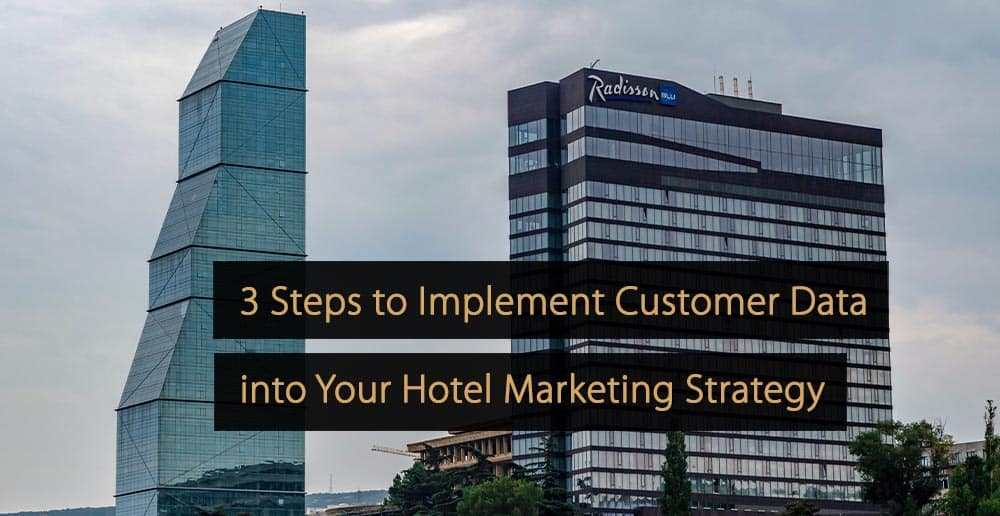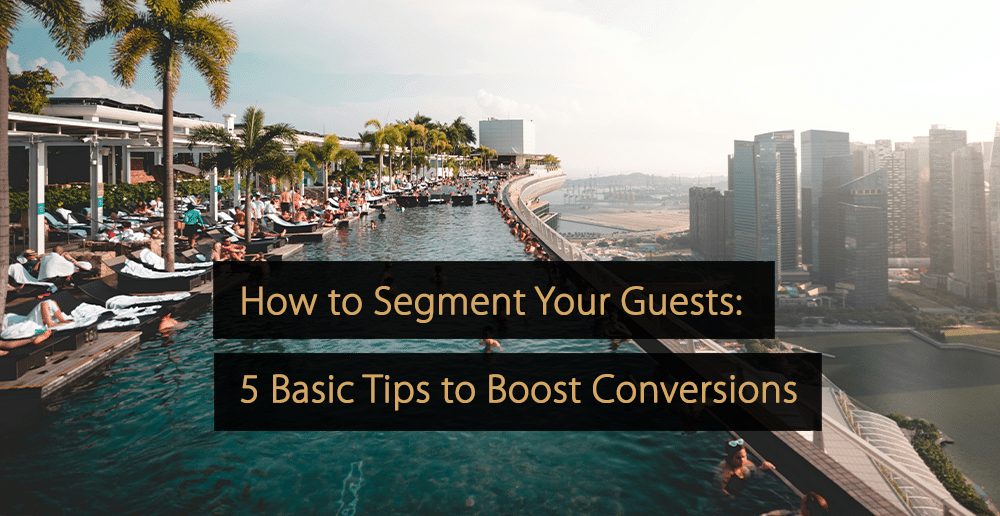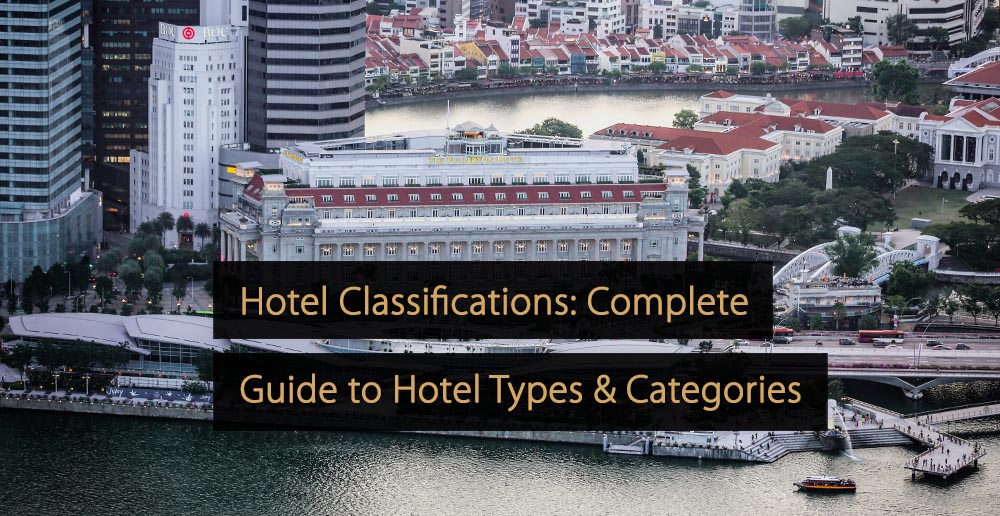Being able to adapt quickly to market demands is a skill many hotel marketers should make an effort to master. And in this digital age, it never hurts to be more data-driven in your overall business strategy. One way to do this is by utilizing customer data in your marketing. By collecting, analyzing, and using customer data, your hotel can customize marketing efforts to effectively target your desired audience and elevate the overall guest experience.
3 Crucial Steps to Implement Customer Data into Hotel Marketing Strategy
These insights guide you to make more informed data-driven decisions and are an easy way to save your team time and money in the long run. And while many hoteliers tend to overlook the power of customer data, making it a focal point in your own strategy is a reliable way to ensure your hotel stays ahead of the competition.
Step 1. Collecting Customer Data
Collecting customer data has become an essential aspect of running a successful hotel. Understanding your guests’ preferences, behaviors, and needs can help you tailor your services to meet their demands more effectively. You gain invaluable insights into your demographic’s behaviors and preferences by gathering this information from diverse sources like direct bookings, online reviews, surveys, loyalty programs, web analytics, and social media platforms. This data consolidation also allows your team to build comprehensive customer profiles and empowers your business to offer more personalized experiences.
Here are the main sources you should be collecting from:
Direct Bookings
Direct bookings serve as a gold mine for hotels, giving them direct insight into customers’ preferences, behaviors, and booking patterns. By analyzing this data, you can identify popular room types, preferred amenities, and even the most effective marketing channels to maximize conversions. This firsthand information empowers you to tailor offerings and create targeted promotions to enhance overall guest satisfaction.
Online Reviews
Online reviews act as a powerful influencer in the world of hospitality. By carefully monitoring and analyzing these reviews, you can better understand guests’ expectations, pain points, and particular interests. By addressing positive and negative feedback, you can make strategic improvements that resonate with your target audience and boost your reputation while attracting new guests.
Surveys
Surveys are an indispensable tool for hotels to collect feedback from guests directly. Ingenious properties use well-crafted surveys to understand what delights, disappoints, or intrigues their guests before, during, and after their stay. This feedback allows hotels to fine-tune their offerings, improve service quality, and anticipate guests’ needs, providing truly personalized experiences.
Loyalty Programs
Loyalty programs serve as an excellent channel for data collection, enabling you to track and segment guests based on travel patterns, spending habits, and preferences. By analyzing this information, you can offer customized perks, promotions, and rewards to foster deeper guest loyalty.
Web Analytics
Through web analytics, hotels can better understand how users interact with their website, which pages are more popular, and where most of the traffic comes from. This information enables you to make data-driven decisions to improve your website’s overall performance.
Social Media Platforms
You can gauge sentiment, identify influencers, and gain insights into emerging trends by actively monitoring social media platforms. Engaging with guests directly on these platforms allows you to respond promptly to feedback, provide assistance, and nurture relationships, all while strengthening your brand’s online presence.
With these insights, you can craft personalized experiences, anticipate needs, and exceed expectations. This builds guest loyalty and drives revenue, positioning hotels for long-term success in an ever-evolving industry.
An Important Note on Data Privacy
While collecting data can benefit your hotel greatly, it’s vital to prioritize consent and privacy. Transparency and trust are key when collecting customer data, so obtaining explicit consent and clearly explaining the purpose of data collection are essential starting points. You should also provide options for customers to opt-out and respect their decision should they choose to do so.
Some best practices for handling customer data include limiting data collection to only what is necessary and relevant, regularly reviewing and updating privacy policies, and conducting internal audits to ensure compliance with the GDPR and CCPA. Implementing a data retention policy can help manage data effectively and minimize risks associated with keeping unnecessary data. By following these best practices, hotels can ensure a positive and secure customer experience.
Step 2. Analyzing Customer Data
The customer data analysis allows hoteliers to identify guest preferences, target demographics, and popular amenities, and measure the success of marketing campaigns. Tools like customer relationship management (CRM) systems, data analytics software, and business intelligence platforms can help translate raw data into actionable insights. This can involve segmenting customers based on demographic information, analyzing past behaviors, and identifying patterns or trends.
Here are some simple techniques to analyze customer data:
Segmentation
Segmenting customers based on demographic information, such as age, gender, location, and income, can help identify different customer groups and tailor marketing strategies accordingly. For example, if you discover that a certain age group is your target market, you can create targeted promotions or offers to attract that specific group.
Behavior Analysis
Analyzing customers’ past behaviors, such as booking frequency, the average length of stay, or preferred room type, can help identify patterns or trends. This information can personalize marketing messages and offers for individual customers. For example, if a customer frequently books suites, you can send them promotions for suite upgrades or special deals on suite bookings.
Sentiment Analysis
Monitoring customer feedback and reviews can provide valuable insights into customer satisfaction and identify areas for improvement. Sentiment analysis tools can help analyze customer reviews to identify common positive and negative sentiments, allowing you to make necessary improvements and build off of what guests enjoy about your hotel.
Predictive Analytics
Utilizing predictive analytics techniques can help hotels anticipate customer behavior and preferences. By analyzing historical data, you can predict future trends, allowing your team to make informed decisions about marketing strategies, pricing, or customer targeting.
Analyzing guest data is essential to gain insights into guest preferences, target demographics, and popular amenities. Utilizing these tools and techniques allows your team to make data-driven decisions to enhance the overall guest experience and generate more bookings.
Step 3: Applying the insights
Utilizing guest data effectively can significantly enhance your marketing campaigns, optimize marketing channels, drive customer loyalty, and improve a guest’s overall experience. You can increase engagement and conversions by tailoring your messages, offers, and promotions based on customer preferences and behavior. Customer data can also enhance guest experiences by anticipating their needs, providing personalized recommendations, and offering customized services.
Here are some ways you can apply customer insights into the guest journey:
Personalization and Targeted Marketing
Today’s guests expect personalized experiences. Guest data provides insights into their preferences, habits, and behavior, enabling you to cater to their needs. By analyzing their preferences and behaviors, you can tailor messages, offers, and promotions that resonate with your audience, resulting in improved engagement and trust. Personalized marketing campaigns also lead to higher conversion rates, increased customer satisfaction, and, ultimately, higher revenues.
For example, sending personalized emails with special promotions or recommendations based on past stays can boost guest engagement and bookings. These personalized emails can include discounts on future bookings, complimentary upgrades, or unique packages that align with each guest’s preferences. Such initiatives demonstrate attentiveness from the hotel’s side and create a sense of importance and exclusivity for the guests.
Improving Guest Experiences through Customer Data
By understanding guest preferences, your hotel can go beyond the “one-size-fits-all” approach and create tailored experiences for each visitor. Harnessing customer data allows your team to anticipate guests’ needs far before they even express them. Analyzing this customer data can help you understand their preferences, enabling you to exceed their expectations.
For instance, if a guest consistently requests extra towels and pillows during previous stays, you can ensure these amenities are readily available in their room upon arrival. This attention to detail sets you apart from your competition and forges strong and lasting connections with your guests, encouraging guests to return and recommend the hotel to others.
Optimizing Marketing Channels for Maximum ROI
You can identify the most successful marketing channels by analyzing customer response rates and engagement data and focus your team’s efforts accordingly. This approach maximizes your return on investment (ROI) by directing resources toward the most impactful channels.
For example, suppose you discover that your email campaigns consistently yield higher response rates and engagement than social media campaigns. In that case, you can allocate more resources toward email marketing to increase customer acquisition and improve conversion rates.
Driving Loyalty through Customer Data Insights
To drive customer loyalty, your team should consider implementing various strategies. This includes segmenting guests based on their preferences and needs, tailoring loyalty programs to cater to different segments, offering personalized rewards and incentives, and implementing targeted retention campaigns.
Your team can use insights to understand guest needs, preferences, and behaviors. This enables you to send personalized emails or messages that feature offers and deals tailored to specific customer segments. For instance, couples celebrating their anniversary may receive a special package with a free spa treatment or romantic dinner.
Utilizing guest data is a great way to enhance loyalty programs and provide personalized rewards. Your hotel can offer tailored incentives by tracking preferences, stay frequency, and spending habits. For example, if a guest frequently books spa services, they may earn loyalty points that can be redeemed for a free massage or exclusive spa access.
By analyzing guest data, you can reward guests based on their preferences and behavior. This includes offering discounts or upgrades to those who frequently book through the hotel’s website or have extended stays.
You can also use these insights to create targeted retention campaigns, like customized messaging with relevant offers and exclusive deals for specific customer segments.
Conclusion
Incorporating customer data into hotel marketing strategies has evolved from being a luxury to an essential practice. By collecting, analyzing, and applying guest data, you can tailor marketing messages, enhance guest experiences, optimize marketing channels, and cultivate unwavering customer loyalty.
The availability of this data is, in fact, an empowering tool for hoteliers to make more informed marketing decisions, boost customer engagement, and drive revenue. By evaluating the effectiveness of various marketing channels, targeting the right audience, and maximizing return on investment, your hotel marketing team can ensure the efficiency and cost-effectiveness of their marketing efforts, establishing continued success in the ever-evolving hospitality industry landscape.
More Tips to Grow Your Business
Revfine.com is the leading knowledge platform for the hospitality and travel industry. Professionals use our insights, strategies, and actionable tips to get inspired, optimize revenue, innovate processes, and improve customer experience.Explore expert advice on management, marketing, revenue management, operations, software, and technology in our dedicated Hotel, Hospitality, and Travel & Tourism categories.








Leave A Comment